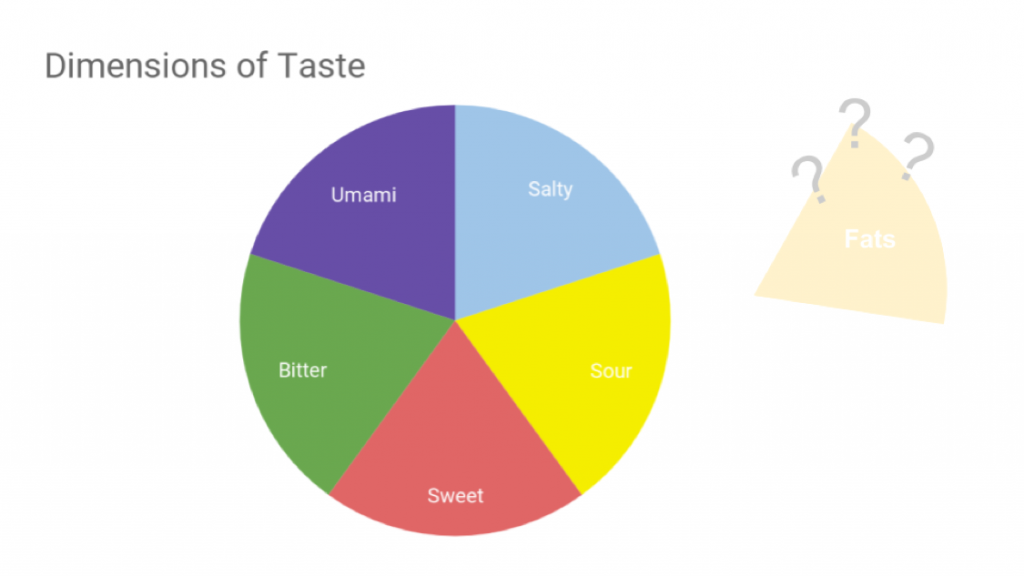Taste and Smell
36 The Dimensions of Taste
Learning Objectives
Be able to describe 6 different dimensions of taste.
Know which 2 dimensions of taste rely on the detection of single ions rather than entire molecules.

Only a few recognized sub-modalities exist within the sense of taste, or gustation. Until recently, only four tastes were recognized: sweet, salty, sour, and bitter. Research at the turn of the 20th century led to recognition of the fifth taste, umami, during the mid-1980s. Umami is a Japanese word that means “delicious taste,” and is often translated to mean savory. Very recent research has suggested that there may also be a sixth taste for fats, or lipids.
Salty taste is simply the perception of sodium ions (Na+) in the saliva. When you eat something salty, the salt crystals dissociate into the component ions Na+ and Cl–, which dissolve into the saliva in your mouth. The Na+ concentration becomes high outside the gustatory cells, creating a strong concentration gradient that drives the diffusion of the ion into the cells. The entry of Na+ into these cells results in the depolarization of the cell membrane and the generation of a receptor potential.
Sour taste is the perception of H+ concentration. Just as with sodium ions in salty flavors, these hydrogen ions enter the cell and trigger depolarization. Sour flavors are, essentially, the perception of acids in our food. Increasing hydrogen ion concentrations in the saliva (lowering saliva pH) triggers progressively stronger graded potentials in the gustatory cells. For example, orange juice—which contains citric acid—will taste sour because it has a pH value of approximately 3. Of course, it is often sweetened so that the sour taste is masked.
The first two tastes (salty and sour) are triggered by the cations Na+ and H+. The other tastes result from food molecules binding to a G protein–coupled receptor. A G protein signal transduction system ultimately leads to depolarization of the gustatory cell.
Sweet taste is the sensitivity of gustatory cells to the presence of glucose dissolved in the saliva. Other monosaccharides such as fructose, or artificial sweeteners such as aspartame (NutraSweet™), saccharine, or sucralose (Splenda™) also activate the sweet receptors. The affinity for each of these molecules varies, and some will taste sweeter than glucose because they bind to the G protein–coupled receptor differently.
Bitter taste is similar to sweet in that food molecules bind to G protein–coupled receptors. However, there are a number of different ways in which this can happen because there are a large diversity of bitter-tasting molecules. Some bitter molecules depolarize gustatory cells, whereas others hyperpolarize gustatory cells. Likewise, some bitter molecules increase G protein activation within the gustatory cells, whereas other bitter molecules decrease G protein activation. The specific response depends on which molecule is binding to the receptor. One major group of bitter-tasting molecules are alkaloids. Alkaloids are nitrogen containing molecules that are commonly found in bitter-tasting plant products, such as coffee, hops (in beer), tannins (in wine), tea, and aspirin. By containing toxic alkaloids, the plant is less susceptible to microbe infection and less attractive to herbivores. Therefore, the function of bitter taste may primarily be related to stimulating the gag reflex to avoid ingesting poisons. Because of this, many bitter foods that are normally ingested are often combined with a sweet component to make them more palatable (cream and sugar in coffee, for example). The highest concentration of bitter receptors appear to be in the posterior tongue, where a gag reflex could still spit out poisonous food.
Umami taste is often referred to as the savory taste. Like sweet and bitter, it is based on the activation of G protein–coupled receptors by a specific molecule. The molecule that activates this receptor is the amino acid L-glutamate. Therefore, the umami flavor is often perceived while eating protein-rich foods. Not surprisingly, dishes that contain meat are often described as savory. For example, foods that have a strong umami flavor include broths, gravies, soups, shellfish, fish (including fish sauce and preserved fish such as maldive fish), tomatoes, mushrooms, hydrolyzed vegetable protein, meat extract, yeast extract, cheeses, and soy sauce.
Fat taste elicited by the digestive products of fat (fatty acids) is yet to be confirmed; however, a growing body of evidence from humans and other animal species provides support for this proposition. In support for a functional significance of fat taste, differences in taste sensitivity for fat appear to predict certain dietary behaviours, i.e. decreased sensitivity to fat taste is associated with an increased consumption of fat, and this has been reported in both animal and human studies. Moreover, sensitivity to fat can be modulated by the diet, i.e. consumption of a high-fat diet appears to maximise the body’s capacity for fat absorption, with no changes in appetite, suggesting that such changes may accompany or encourage excess fat intake and obesity. These data propose a direct role of the taste system in the consumption and preference of high-fat foods, which may be linked to the development of obesity given that differences in BMI have also been linked to oral fatty acid sensitivity. The mechanism allowing for increased consumption of fat is proposed to be via satiety or fullness signals, as associations in both taste and digestive responses to fat have been reported. The next 5 to 10 years should reveal, conclusively, whether fat can be classified as the sixth taste, but no matter what, there appears to be a functional significance to oral chemosensing of fats.
CC LICENSED CONTENT, SHARED PREVIOUSLY
OpenStax, Anatomy and Physiology Chapter 14.1 Sensory Perception
Provided by: Rice University.
Access for free at https://openstax.org/books/anatomy-and-physiology/pages/14-1-sensory-perception
License: CC-BY 4.0
Adapted by: Rowan Sexton
BioMed Central, Is fat the sixth taste primary? Evidence and implications
Provided by: BioMed Central Ltd.
URL: https://flavourjournal.biomedcentral.com/articles/10.1186/2044-7248-4-5#citeas
License: CC BY 4.0
Wikipedia, Umami
Provided by: Wikipedia
URL: https://en.wikipedia.org/wiki/Umami#Taste_receptors
License: CC BY-SA 3.0
Quiz by: Chaire Radtke
References
Keast, R.S., Costanzo, A. Is fat the sixth taste primary? Evidence and implications. Flavour 4, 5 (2015). https://doi.org/10.1186/2044-7248-4-5

